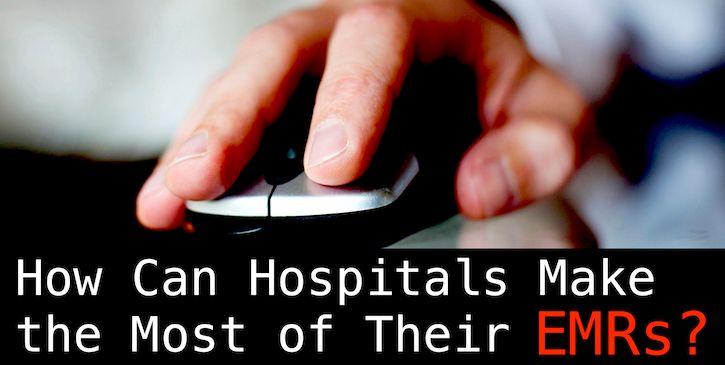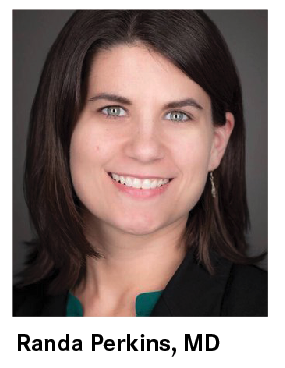How Can Hospitals Make the Most of Their EMRs?
Despite widespread adoption of the technology, health systems and clinicians are still trying to find best practices.

A decade ago, a visit to an emergency department looked very different than it does today. A patient complaining of a migraine would have been triaged by a nurse who jotted notes by hand. The records would have been physically passed from nurse to doctor or faxed from one department to another. The patient might have been automatically sent for a CT scan, as staffers would not know that one had been performed elsewhere a few weeks earlier. Even if the patient said as much, the hospital staff could not have accessed the results. The doctor also might have discharged the patient with a prescription—without knowing what other medications the patient might be taking and whether there was a risk of drug interactions.
Thanks to the near-universal adoption of electronic medical records (EMRs), the landscape has changed dramatically in the past 10 years. According to the Office of the National Coordinator for Health Information Technology, before 2009, most doctors’ offices, hospitals, and other healthcare organizations used paper-based data entry systems and relied on fax machines to transmit information. At least 87% of physicians’ offices now use EMRs compared with just 42% in 2008, and more than 95% of hospitals eligible for Medicare and Medicaid’s Electronic Health Records Incentive Programs, which were created to encourage the adoption and use of EMR technology, rely on the technology.
Today, upon arrival, a patient’s data enter the hospital’s files electronically. In theory, notes from previous medical visits appear, along with tests, existing medical conditions, and prescribed drugs. Information can be shared instantly among clinicians.
Stumbling Blocks
Love them or hate them, many healthcare facilities and physicians’ offices could be doing a better job of using EMR systems to their full potential. There’s no doubt that certain barriers and obstacles must be addressed by vendors and users to make the experience a much smoother, more productive one.

“There is absolutely a lot of frustration with EMRs,” Peter Winkelstein, MD, MS, MBA, FAAP, chief medical informatics officer for UBMD and Kaleida Health, both Buffalo, New York-based healthcare providers, told Healthcare Analytics News™. “There is a perception among physicians that EMRs have reduced the efficiency of healthcare delivery.” Although that might not be true for all healthcare professionals, if enough people on the front lines of medicine perceive EMRs as a barrier to quality care rather than an enabler of it, that indicates a persistent problem.
One thing that can make an EMR cumbersome is that it involves a lot of clicks. “Physicians like to count clicks,” said Winkelstein, highlighting the fact that time-pressed doctors and nurses are likely to find onerous any system that involves dealing with multiple steps. Another stumbling block is an EMR’s lack of interoperability, according to Levin. “The ability to share information between, and across, EMR systems remains a huge problem and one of the biggest barriers to success and innovation,” he said. “For example, many people are surprised to learn that moving data between 2 instances of the same brand of EMR is difficult.” A hospital that uses multiple EMR brands can find the ability to share information severely compromised.
With all of this potential sharing of information at the click of a mouse, what about patient privacy? The Department of Health & Human Services’ Office for Civil Rights suggests that hospitals and doctors’ offices use passwords and PINs to ensure that only authorized employees have access to the system and recommends that stored data be encrypted and accessible only with an electronic key. EMR systems also should feature the ability to track who accesses medical records, when the records are accessed, and what changes, if any, are made.
Cost Concerns
Investing in EMR technology means shelling out big bucks. If staff aren’t adept at leveraging all of an EMR’s features, or using the system at all, it can feel like an expensive waste. But some healthcare providers recognize that time saved is money in the bank.
When Utah-based Intermountain Healthcare recently purchased an EMR system, the cost was on the decision-makers’ minds, said Stanley M. Huff, MD, clinical professor of biomedical informatics at the University of Utah and chief medical informatics officer at Intermountain. Similar to the actions of hospital executives, Intermountain accepted reimbursements available through the government’s Medicare and Medicaid Electronic Health Records Incentive Programs, totaling about $28 million in a year.
However, Huff said that the restraints of that incentive payment, such as the requirement that physicians personally interact with the EMR system instead of outsourcing the job to other clinicians or support staff, have proven onerous and time-consuming. If Intermountain could go back in time, Huff said, the company likely would not have accepted the government payments.
By analyzing the time saved on numerous tasks, Charlotte, North Carolina-based Atrium Health has been able to put a number on the value of its EMR system. Last year, it reported that nurses reduced the time it takes them to assess and document patients by 20%, or 35,000 working hours. The company also has seen its on-time medication administration rise by 14%. And by implementing a variety of new screening tools in the EMR, the quality of patient assessments has improved enough that Atrium is saving $60,000 a year in third-party costs.

Patients Benefit
It’s no secret that many doctors and nurses have a love-hate relationship with EMRs. For all of their promise, these systems often are a source of frustration and wasted time. Nevertheless, some clinicians have realized that patients directly benefit from the use of this technology.

Because Jayant Jagannathan, MD, operates 4 clinics in central and northern Michigan, the interchangeability of an EMR helps him keep track of his patients, some of whom live in the farthest reaches of the state near the Canadian border. They occasionally come downstate for treatment but often can’t manage frequent travel. “I can be sitting in a hospital here and be looking at a chart for a patient 300 miles away,” Jagannathan said. The electronic system is also a great help when he confers with his partner, who may be in another location. “So we don’t miss a beat when it comes to patient care.” He also appreciates that he no longer has to sift through “huge and overwhelming” physical charts when looking for a particular piece of information.
Patient privacy is another selling point for Jagannathan. He pointed out that without EMRs, records must be printed by someone in the medical records department, physically mailed or faxed to another clinician, and then manually scanned into a new system. “There are 3 different areas there where protected information could be contaminated,” he said. Restricting use of passwords and PINs only to those who should have access keeps his patients’ data safe.
Becky Fox, RN, described a time when EMR technology made a difference for a young man who showed up at one of the system’s emergency departments. “If you eyeballed him, you’d think he was fairly healthy,” said Fox, assistant vice president and chief nursing informatics officer at Atrium Health. However, she noted that this patient’s lab results were flagged in the EMR system for possible sepsis. “We were able to intervene quickly and get the patient moved up to the critical care area,” she said. “It was a really ‘aha’ moment for the nursing staff.” Fox also recalled the time a friend’s mother arrived at the hospital and was flagged for Clostridium difficile testing by the EMR, which was fortuitous because she ended up testing positive for the infection.
The Years Ahead
Unfortunately, too many hospitals and physicians’ practices aren’t yet using EMRs at this advanced level. Experts agree, however, that the next frontier for EMR is moving from capturing raw data and making it easy to find and share to analyzing and making suggestions, as in the sepsis and C. difficile scenarios. “Predictive analytics, which have transformed the retail and finance sectors, will begin to impact medicine,” said David Levin, MD, chief medical officer at Minneapolis-based Sansoro Health. “Today, Amazon makes ‘people who bought this’ recommendations. Tomorrow, EMRs will make ‘patients like this have a high risk of’ or ‘patients like this respond best to drug X’ recommendations.” He likens current EMR systems to the first generation of cars more than a century ago. “[EMR systems today] are more like the Model T than a sleek, self-driven sports car.”
Winkelstein compared EMRs today with where Google and Apple were a few years ago. Back then, you could use map applications to help you figure out where you were, but not much else. Now, he said, the applications are smarter and can point you to the nearest craft cocktail bar. “We’re not there yet with EMRs,” he said. “Right now, most physicians see them as data entry devices.”
The good news, according to Winkelstein, is that EMR systems are becoming more responsive. “For the past few years, vendors [have been] concentrating on regulatory compliance,” he said. “Now they’re beginning to be able to focus on how to

make [the systems] more user friendly.” While he’s heartened by EMRs’ abilities to flag patients for certain conditions, he wants systems to go further, such as alerting clinicians that patients need screening tests, such as mammograms or colonoscopies, based on their ages or medical histories.
All of these alerts, however, can lead to sensory overload. “Research by informaticians has shown that there are beneficial aspects to EMR implementations, including decreased transcription risk via electronic entry and decreased medication administration errors via barcoded medication administration,” said Randa Perkins, MD, chief medical information officer at Moffitt Cancer Center in Tampa. “However, we are aware that we traded old errors for new ones. For example, well-intended alerts have fed ‘alert fatigue’ and possibly contributed to provider and clinician burnout concerns.”
Will clinicians want to, or be able to, adapt as EMRs evolves? No one claimed adapting will be easy for clinicians who are used to doing things a certain way.
“I think everyone’s getting used to the fact that [things are] always going to change,” Fox said. “It’s important to have clinicians in executive roles at the table.” As with other industries, younger people working in healthcare are more likely to take to the new systems fairly easily. She noted that a substantial portion of the nurses who work at Atrium Health are millennials, which bodes well for their embrace of new electronic methods. “Millennials are willing to take risks,” she said.
Perkins is optimistic that clinicians eventually will wholeheartedly embrace EMRs. “Eventually we will see EMRs and their related functions as being as essential to healthcare as the stethoscope,” she said. “Once that happens, we’re more likely to get more of the relevant and accurate data that healthcare research needs to make discoveries faster and make personalized medicine a reality.”
Healthy Bottom Line: The Trouble With SDOH Programs and the Secret to Improving Them
September 28th 2021Several problems exist with current programs that address social determinants of health (SDOH); however, a new social model aims to combat these issues and improve the programs’ effectiveness.